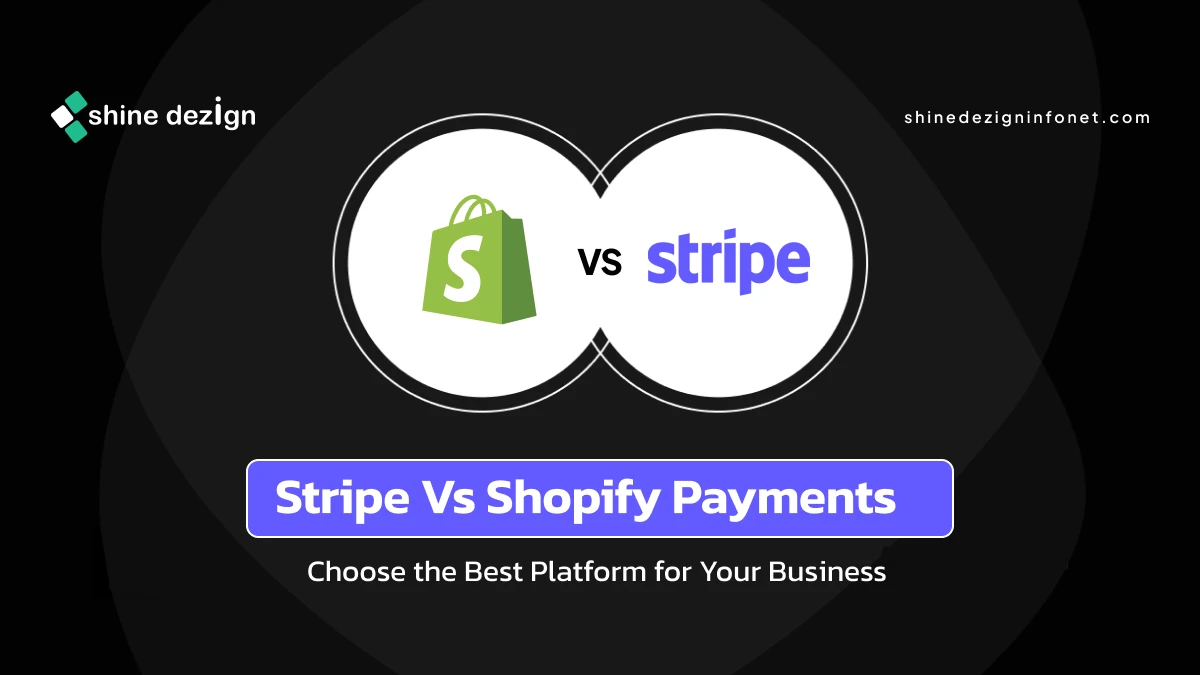Table of Contents
- Introduction
- What is Stripe Payment?
- What are the features of Stripe Payments?
- What are the Pros and cons of Stripe payments payment methods?
- What is Shopify payments?
- What are the features of Shopify Payment?
- What are the Pros and cons of Shopify payment?
- Comparison table – Stripe payments Vs Shopify Payments:
- Why choose Shopify payments over Stripe payments?
- Summing Up
As the trend of digitalization is increasing in businesses, almost every store owner is setting up their stores online either for products or services. While setting up your store online, it is important to decide an appropriate payment method for your online store. There are various payment methods available for online stores.
These payment methods provide different Facilites, features, and benefits to the e-Commerce business owners. These payment methods are Shopify payments, Stripe payments, PayPal, Worldpay, Verifone, etc. In this blog, you will get comprehensive detail on Shopify vs Stripe payments including their features, advantages and disadvantages. Along with this, you can analyze this payment method via the comparison table.
What is Stripe payment?
 Stripe payments is a software payment platform, launched in 2010 by Irish entrepreneurs Patrick and John Collison, that aims at providing simplified payment options for all the online businesses despite its size. It offers a suite of payment processing tools, including online and mobile payments, invoicing, subscription billing, and more. Stripe payments is known for its developer-friendly API and its focus on innovation.
Stripe payments is a software payment platform, launched in 2010 by Irish entrepreneurs Patrick and John Collison, that aims at providing simplified payment options for all the online businesses despite its size. It offers a suite of payment processing tools, including online and mobile payments, invoicing, subscription billing, and more. Stripe payments is known for its developer-friendly API and its focus on innovation.
Stripe payments allow businesses to accept payments in various international and local currencies and it is supported in more than 40 countries. In 2023 as per Kinsta, Stripe payments enjoyed a market share value of 19.44%, second only to PayPal in the payment processing category.
What are the features of Stripe payments?
Stripe payments payment method has following features: –
Popularity:
Stripe payments are widely accepted by every customer, especially by those who don’t have a credit card. It supports 100 payment methods like cards, bank deposits, bank debits, bank redirects, real-time payments, etc. Stripe payments payment supports more than 135 local and international currencies. It is supported in 45+ countries.
Integration:
Stripe payments provide seamless integration options like (APIs, SDKs, etc.). It offers extensive documentations, SDKs, and libraries for various platforms and languages. It is compatible with different e-commerce platforms.
Transaction Fees:
It offers a flexible and customizable payment gateway. It requires no monthly fees. Its chargeback rate is 0.4% per transaction.
Security:
Data protection, fraud prevention, and regulatory compliance are provided for favorable business operation.
Customization & Flexibility:
It seamlessly creates invoices and payment links that can be customizable. It offers flexibility in payout schedules; that is daily, weekly, and monthly payouts depending on business preferences.
What are the Pros and Cons of Stripe Payments methods?
 Despite having so many features, Stripe payment has many advantages that make it stand out from others and along with these many disadvantages making it unfavorable for small business.
Despite having so many features, Stripe payment has many advantages that make it stand out from others and along with these many disadvantages making it unfavorable for small business.
| Pros of using Stripe Payments | Cons of using Stripe payments |
| Stripe payment is highly customizable. | Setting up Stripe payments is a complex task as it consumes more time. |
| Stripe payment works seamlessly with e-commerce platforms. | Due to its complexity and advancements, it costs more. |
| It has robust tools for managing payments and subscriptions. | It has possible higher transaction fees. |
| It supports more than 135 international and local currencies. | Not suitable for small businesses. |
| Stripe payment has wider reach as it is supported in 46 countries. | It has a strict chargeback policy, making it unfavorable for some businesses. |
| It facilitates detailed transaction details to the user. | Stripe payments doesn’t offer phone support features. |
| Stripe payment supports diverse payment methods. | It has a strict chargeback policy. |
What is Shopify Payments?
 Shopify is an e-commerce platform that allows businesses to create online stores, manage products, process orders, and handle shipping. Shopify Payments is the integrated payment processing solution offered by Shopify. It is an in-house payment integration feature, launched in 2013. It was designed to provide a streamlined, user-friendly and easy payment method for businesses at Shopify. It seamlessly integrates with the Shopify platform, making it easy to set up and use.
Shopify is an e-commerce platform that allows businesses to create online stores, manage products, process orders, and handle shipping. Shopify Payments is the integrated payment processing solution offered by Shopify. It is an in-house payment integration feature, launched in 2013. It was designed to provide a streamlined, user-friendly and easy payment method for businesses at Shopify. It seamlessly integrates with the Shopify platform, making it easy to set up and use.
The major benefit of Payments on Shopify lies in its seamless integration with Shopify business stores. When using this gateway, business owners don’t have to set up any third-party payment service providers or merchant accounts, thus it eliminates the potential complications and delays in receiving and accepting payments.
What are the Features of Shopify Payments?
Shopify Payment Gateway method has following features: –
Integration:
It is seamlessly integrated with Shopify online businesses without any requirement of external applications or set ups. It is exclusively available for the Shopify platform users.
Transaction Fees:
There are no additional transaction fees for Shopify except credit cards as credit card rates apply (but these vary by plan). There are no charges for a few invoices for a month, beyond the limit charges will be applied.
Security Features:
Shopify uses PCI compliant for security and compliance. It offers secured checkout with Address Verification Services and Card Verification as it values fraud filters. It includes a basic fraud analysis tool which can be upgraded to comprehensive fraud prevention.
Payment Methods:
Using Shopify, businesses can accept and manage payments using Credit cards and debit cards. Along with this, Shopify supports many alternative payment methods like Google pay, Apple pay, etc. Which helps Shopify to cater to a large range of consumer preferences.
Other Features:
● You can get customization service if you opt for Shopify plus.
● Shopify dashboard has a built-in reporting system that helps in analyzing the sales, payments, orders and more.
● Shopify provides help centers, community forums and direct support for the customers.
● Users get chargeback support and claims through Shopify.
What are the Pros and Cons of Shopify Payments Methods?
Shopify payment method has various advantages and disadvantages: –
| Advantages of using Shopify payment | Disadvantages of using Shopify payment |
| Seamless integration, directly built in with Shopify. There is no need for third party integration. | Shopify payment is only available in selected countries.
|
| It offers chargeback support for the users. As Shopify directly handles the chargeback and disputes. | Shopify only works for Shopify merchants.
|
| It is suitable for businesses of all types and levels. | It cannot be used standalone.
|
| It offers seamless and user-friendly payment processing experience. Shopify provides flat transaction fees without any hidden charges. | For using advanced features like customization, you need to use Shopify premium.
|
| It accesses business funding in some regions without credit cards and customers receive payouts quickly; within 2 – 3 working days. | There are no bank transferring features available while using Shopify payments. |
Comparison table – Stripe payments Vs Shopify payments:
As there are various and many different features which are offered by both Shopify payments vs Stripe, it is slightly difficult to figure out the perfect payment methods for your business. Here in this blog, we provide you with the Comparison table between Shopify and Stripe; to help you differentiate between these two keenly: –
| Factors | Stripe payments | Shopify |
| Definition | Patrick and John Collison founded Stripe payments, a major payment processing platform that serves companies in 40+ countries. It’s the second largest processor after PayPal and takes up 19.44% of the payment processing market share | Shopify Payments seamlessly integrates with the Shopify platform, eliminating the need for third-party payment providers and merchant accounts. This in-house solution, launched in 2013, provides a streamlined and user-friendly payment processing experience for businesses |
| Features | It provides payment links and invoices and Virtual cards. Another feature includes Donations, Real-time payments, Advanced fraud detection using Stripe payments Radar’s machine-learning. Along with this, 3D Secure feature, Extensive APIs and SDKs with Identity verification option and feature of Data & analytics | – It offers Seamless integration with Fraud prevention and Dispute management. Features like Fast payouts, Order and payment management are also provided. Subscriptions and recurring payments feature with Shop Pay and POS integration |
| Target Audience | Best suited for merchants already using the Shopify platform looking for a straightforward, integrated payment solution | Suited for a wide range of businesses, from startups to large enterprises, seeking flexible payment solutions |
| Pricing | 2.9% + 30¢ per successful charge (for domestic cards) | There are no additional transaction fees for using Shopify Payments, but credit card rates apply, and it varies by plan |
| Set up | Complex set up for non – technical users | Seamless set up and integrations due to built-in quality |
| Currencies | Supported by 135+ currencies | 14 currencies |
| Countries | Available in 46 countries | Available in 23 countries |
| Cards | Major credit cards: Visa, Mastercard, American Express, Discover, Diners Club, JCB, and more | Visa, Mastercard, Maestro, American Express, Discover |
| Payment method accepted | 100+ payment methods accepted | Debit cards, credit cards, wallet payments, international and local payment, and manual payments for pick up orders |
| Bank transfers | ACH transfers (US), SEPA Direct Debits (Europe), BACS Direct Debits (UK), Faster Payments (UK) and more | Not available |
| Payout schedules | Customizable payout schedules | Payout schedule within 2 – 3 business days |
| Customizations | Customize payment invoices and links | Customization options available with Shopify plus |
| Chargeback | Strict chargeback policy | Supportive in Chargeback and dispute through Shopify |
| Chargeback rate | 0.4% per transaction | The chargeback fee on Shopify covers the cost of processing of the dispute |
| Customer support | Stripe payment lacks in providing phone support but offer extensive support through documentations, community forums and many other | Shopify provides help centers, community forums and direct support |
| UI | It provides a clean dashboard design for both technical and non – technical users | Simple user interface, easy to navigate |
| Learning curve | Steep learning curve | Low learning curve |
Why choose Shopify payments over Stripe payments?
 After comparing Shopify payments vs Stripe you can prefer Shopify payments instead of Stripe payments. Because:
After comparing Shopify payments vs Stripe you can prefer Shopify payments instead of Stripe payments. Because:
● Shopify payments is easy to use as compared to Stripe payments.
● Stripe payments can be integrated to Shopify, so it is beneficial for your business.
● It is easy to set up without any requirement of third-party integration.
● It offers competitive transaction fees and no additional monthly fees.
● If you are using the Shopify platform, Shopify Payments is the most straightforward and integrated option.
● Use Shopify payments if you are looking for all features in one platform.
Summing Up
Both the Shopify payments and Stripe payments have proven beneficial to your business in several ways. They incorporate many features, and benefits. Both the payment methods have various advantages and disadvantages. The choice between Shopify vs. Stripe Payments ultimately depends on the specific needs and priorities of your business.
If you prioritize flexibility, customization, and advanced features, Stripe payments might be a better choice. However, if you’re primarily using the Shopify platform and value simplicity and ease of use, Shopify Payments is likely the better option.




















